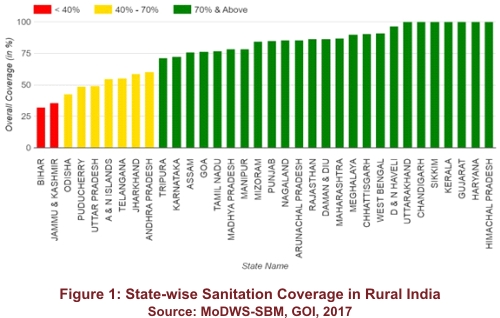Drive towards a Common Goal: Healthy Living
Current Status of Sanitation in Rural
Households of India
India
has a lot higher open defecation rates than other developing countries. For
e.g. in rural Bangladesh, only 5% of people defecate in the open whereas, in
rural China, 2% of people defecate in the open (Diane Coffey, 2017). Rural
India has witnessed 29.29% increase in Individual Households (IHH) with
toilets. From 38.7% in October 2014, this has risen to 67.99% in April 2017
(MoDWS, 2017). Figure 1 shows the state- wise sanitation coverage in rural
India indicating that 6 states namely Himachal Pradesh, Haryana, Gujarat,
Kerala, Sikkim and Uttarakhand have been declared Open Defecation Free (ODF).
Only 2 states - Bihar and Jammu & Kashmir are still below 40% sanitation
coverage.
Swacchta: Lifestyle to adopt or Target to achieve
According to Swacchta status report conducted by the National Sample Survey
Organisation (NSSO) for the period July 2014 - June 2015, 73,176 households
were surveyed in rural India covering approximately 3788 villages. Of the
total households surveyed, 45.3% reported having toilets and 95.6% of these
households with toilets, reported to use household/ community toilets.
Despite such huge numbers reported, it also found that 52.1% of people
surveyed still go for open defecation. The main reason behind is due to
beliefs, values and norms of purity, pollution, caste and untouchability.

According to the fund utilisation statements of states in 2016-17, the low spending of IEC fund has severely impacted the quality and quantity of the SBM targets. For e.g. Only 30% of the states have IEC plan in place and only 5 states have appointed district IEC consultants (IEC Guidelines for States and Districts, 2017).
With increasing focus on SBM, for the FY 2017-18, INR 3,625 crores is allocated which is 27% more than the same for FY 2014-15. However, it is important to note that funds allocated for behaviour change campaign activities have been reduced by half from 15% in 2014- 15 to 8% in 2015-16 (Nikhil Srivastav, Aashish Gupta, 2015).
Recommendations
Though there are many agents of change it is important to tap the right
sentiments of the community. Most of the time, rational sentiments like
better health on account of use of toilets is often defeated. Therefore,
attempts are made to use emotional appeals like Responsible Citizen' to
serve the purpose.
One of the greatest learning from failures of the previous schemes is the
need to put in place a comprehensive monitoring and evaluation framework for
an effective behavioural change of the rural population. It is necessary to
track both output and outcome and thus accordingly measure the indicators
for the same. While constructing toilets is an output indicator under the
programme, toilet use is an outcome indicator and is critical to measuring
the programme's achievements (Sanganeria, 2015).
■
References:
Coffey, D., Gupta, A., Hathi, P., Spears, D., Srivastav, N., & Vyas, S. (2017, January 7). Understanding open defecation in rural India: Untouchability, pollution, and latrine pits. Economic & Political Weekly, 52(1).
Gopalakrishnan, S. (2015). Budget 2015: Sanitation And The Swachh Bharat Mission. Retrieved from India Water Portal: http://sanitation.india waterportal.org/ english/node/3234
IEC Guidelines for States and Districts. (2017).
MoDWS. (2017). Swachh Bharat Mission- Gramin (All India). Retrieved from http://sbm.gov.in: http://sbm.gov.in/ sbmreport/home.aspx
Nikhil Srivastav, Aashish Gupta. (2015). Sanitation budget allocations for 2015-16 cut- spending on behaviour change declines. Retrieved from Livemint.com: http://www.livemint.com/Opinion/b6XOmxNBkTr5MtjvgMoGyH/Likeitspredecessors-Modissanitationprogramme isstrugg.html
Sanganeria, A. (2015). Fortifying Swachh Bharat Mission. Retrieved from Livemint.
Srijani Hazra
Deputy Manager, Habitat Solutions
Development Alternatives
shazra@devalt.org